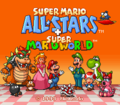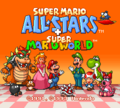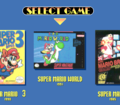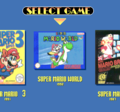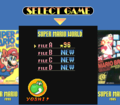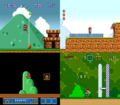|
|
| (65 intermediate revisions by 33 users not shown) |
| Line 1: |
Line 1: |
| {{italic title}} | | {{italic title}} |
| {{Infobox | | {{game infobox |
| |image=[[File:SMAS+SMW_Boxart_NA.jpeg|250px]]<br>North American box art | | |image=[[File:SMAS SMW.jpg|250px]]<br>European box art |
| | <!--ANY AMERICAN BOX ARTS ARE FAKE. The American release was part of a system bundle and was never released on its own.--> |
| |developer=[[Nintendo Entertainment Analysis and Development|Nintendo EAD]] | | |developer=[[Nintendo Entertainment Analysis and Development|Nintendo EAD]] |
| |publisher=[[Nintendo]] | | |publisher=[[Nintendo]] |
| |platforms=[[Super Nintendo Entertainment System]] | | |platforms=[[Super Nintendo Entertainment System]] |
| |released={{released|USA|December 1994|Europe|1995}} | | |release={{release|USA|December 1994|Europe|1995}} |
| |genre=Platformer | | |genre=Platformer |
| |modes=1-2 players | | |modes=Single player, multiplayer (up to two players) |
| |ratings={{ratings|esrb=K-A}} | | |ratings={{ratings|esrb=K-A}} |
| |media={{media|snes=1}} | | |media={{media|snes=1}} |
| |input={{input|snes=1}} | | |input={{input|snes=1}} |
| }} | | }} |
| '''''Super Mario All-Stars + Super Mario World''''' is a compilation title for the [[Super Nintendo Entertainment System|SNES]]. It includes all the games from ''[[Super Mario All-Stars]]'', as well as ''[[Super Mario World]]''. It was released in December 1994 in North America, 1995 in Europe and was never released in Japan. The game was usually packaged with the console as the Super NES Mario set, in North America the game was available exclusively as such. | | '''''Super Mario All-Stars + Super Mario World''''' is a compilation title for the [[Super Nintendo Entertainment System]]. It includes all the games from ''[[Super Mario All-Stars]]'', as well as ''[[Super Mario World]]''. It was released in December 1994 in North America and 1995 in Europe, but it was never released in Japan. The game was usually packaged with the console as the Super NES Mario set, and in North America, the game was available exclusively as such. |
|
| |
|
| The original ''Super Mario All-Stars'' title screen changes somewhat to accompany the additional game. The background and linoleum color changes from blue to orange and blue to pink respectively, ''Super Mario World'' is added to the logo, and [[Birdo]] moves a bit forward, and sits down to make room for [[Yoshi]], who is added in the background, in addition to more minor alterations. | | The original ''Super Mario All-Stars'' title screen changes somewhat to accompany the additional game. The background and linoleum color changes from blue to orange and blue to pink respectively, ''Super Mario World'' is added to the logo, and [[Birdo]] is moved slightly forward and sits down to make room for [[Yoshi]], who is added in the background, in addition to [[Princess Peach|Princess Toadstool]]'s crown having its shading fixed and Bowser having his nose shifted sightly. On the game-selection screen, the ''[[Super Mario Bros.: The Lost Levels]]'' cover is now labeled as "Unreleased in the USA" underneath ("Unreleased in Europe" in the European release), with the 1986 release date removed; this is unlike the original in which only advertisements mentioned its Japan-exclusive status. |
| | |
| | Unlike in the other four games, the controls cannot be switched in ''Super Mario World'' due to the [[Spin Jump]]; as a result, underneath the file menu for ''Super Mario World'', instead of a control configuration option, there is an orange circular icon with Yoshi on it, with text reading "YOSHI!" below it. Selecting a file of the game has him winking at the player. |
|
| |
|
| The European box art of the game has slightly changed to reflect the addition of ''Super Mario World''. | | The European box art of the game has slightly changed to reflect the addition of ''Super Mario World''. |
|
| |
|
| ==Differences from ''Super Mario World''== | | ==Differences from ''Super Mario World''== |
| [[File:SMW-SMASSMW Luigi.png|200px|thumb|left|The differences in Luigi's sprite sets between the original version above and the ''All-Stars'' version below.]] | | [[File:SMW-SMASSMW Luigi.png|200px|thumb|left|The differences in Luigi's sprite sets between the original version above and the ''All-Stars'' version below]] |
| Although there are no huge differences to the game unlike the other games in ''Super Mario All-Stars'', there are a few minor differences, such as the sprites for [[Luigi]] in ''Super Mario World''. In the original game, Luigi's sprite set is identical to [[Mario]]'s, save for the greener color palette in order for the second-player character to be identified as "Luigi". For the ''All-Stars'' edition, Luigi's sprite set was completely revamped in order to for the character to appear different than Mario as he is now taller and thinner, resembling his current appearance, and performs various action poses differently (for instance, Mario slides down slopes on his bottom, but Luigi slides down on his knees). Luigi also spits [[fireball]]s rather than shooting them from his fingers, resembling the attack of a [[Fire Bro]]ther. In his Super form and other power ups, when standing still he keeps his hands relaxed instead of clutching on his overalls. The changes in the sprite designs were purely cosmetic, as Luigi's gameplay performance remains identical to Mario's, unlike the gameplay performance in the later remake ''[[Super Mario World: Super Mario Advance 2]]''. | | Although there are no major differences to the North American game, there are a few minor differences, such as the sprites for [[Luigi]] in ''Super Mario World''. In the original game, Luigi's sprite set is identical to [[Mario]]'s, save for being assigned green palette colors. For the ''All-Stars'' version, Luigi's sprite set was remade in order for the character to appear more distinctive, as he is now taller and slimmer than Mario, resembling his ''[[Super Mario Bros. 2]]'' appearance. Luigi performs various action poses differently (for instance, Mario [[slide]]s down slopes on his bottom, but Luigi slides down on his knees). [[Fire Mario|Fire Luigi]] also spits [[fireball]]s rather than shooting them from his hands, resembling the attack of a [[Fire Bro]]ther; this is not repeated in future games. As [[Super Mario (form)|Super Luigi]] and other powered-up forms, when standing still, he keeps his hands relaxed instead of clutching on his overalls. The changes in the sprite designs were purely cosmetic, as Luigi's gameplay performance remains identical to Mario's, unlike the gameplay performance in the later reissue ''[[Super Mario World: Super Mario Advance 2]]''. However, not all of Luigi's sprites were changed; for example, [[crouch|duck]]ing while holding an object or [[dash|run]]ning up walls via a [[Triangular Block]] still shows the original Mario-esque sprite for that respective action. This sprite set was again used in ''[[Super Mario Maker 2]]'', albeit his lower body resembling Mario's. Also, ''Super Mario World'' now has four save files like the rest of the games in ''Super Mario All-Stars'', where the original version had only three, and while on the map screen, the player can press the {{button|snes|select}} button to reveal the option of either continuing the game or quitting; neither option saves the game, unlike in the other games. The game's save feature is identical to the original game's, allowing the player to save only after they complete a [[castle]], [[fortress]], [[Ghost House]], etc. Because of the nature of the file select, the player select screen is now shown after starting the game. While the other games do not allow a change in the number of players after a game is started, ''Super Mario World'' allows the player to change between one and two players even when resuming a saved game, as with the stand-alone version. |
|
| |
|
| Also, ''Super Mario World'' now has four save files similar to the rest of the games in ''Super Mario All-Stars'', where the original version only had three, and while on the map screen, the player can press the select button to reveal the option of either continuing the game or quitting, neither option saves the game, unlike the other games. The game's save feature is identical to the original game, only allowing the player to save after completing a castle, fortress, ghost house, etc. The file select is before starting the game, in the same fashion as the other four games, and when the title screen shows, pressing a button simply brings up the number of players selection. While the other games do not allow a change in the number of players after a game is started, ''Super Mario World'' allows the player to change between one and two players even when resuming a saved game, as with the stand-alone version.
| | ==Glitches== |
| | ''Super Mario Bros. 2'' had two glitches introduced, one where the pause screen would appear faster each time it was opened, and another where going through a [[Magical Potion]] door at the same time the potion goes off causes the game to softlock, the latter of which was fixed in the European version.{{ref needed}} |
|
| |
|
| ==Gallery== | | ==Gallery== |
| <gallery> | | <gallery> |
| SMAS SMW.jpg|European box art | | SMAS+SMW in-game logo.png|In-game logo |
| SNES Box SMAS.jpg|SNES release with SMAS+SMW as a pack-in | | Super Mario All-Stars World Title Screen.png|Title screen (North American) |
| Super Mario All-Stars World Title Screen.png|A screenshot of the title screen | | SMAS+SMW Title Screen EU.png|Title screen (European) |
| | SMAS SMW Game selection menu screen.png|Game selection menu screen (''Super Mario World'') |
| | SMAS SMW Game selection menu screen EU.png|Game selection menu screen (European, ''Super Mario World'') |
| | SMASSMW96.png|A ''Super Mario World'' file with all 96 exits found |
| | SMAS SMW YOSHI! icon.png|The "YOSHI!" icon |
| | Levelsend.png|The ending of each of the first [[level]]s excluding ''Super Mario Bros.: The Lost Levels'' |
| | SNES Box SMAS.jpg|North American SNES bundle with ''Super Mario All-Stars + Super Mario World'' as a pack-in |
| | SNES Super Mario 5 Stars Pack bundle.jpg|European SNES bundle with the game |
| | SMAS Plus SMW Cartridge.jpg|North American cartridge |
| </gallery> | | </gallery> |
|
| |
|
| ==Trivia== | | ==Trivia== |
| *Although this game was released in late 1994 and 1995 in North America and Europe respectively, the copyright year still says 1993 on the title screens like the predecessor. | | {{NIWA|StrategyWiki=1}} |
| | *Although this game was released in late 1994 and 1995 in North America and Europe, respectively, the copyright year still says "1993" on the title screens like the predecessor. |
|
| |
|
| {{MarioGames}} | | {{Super Mario games}} |
| {{SNES}} | | {{SNES}} |
| [[Category:Super Mario All-Stars|*]] | | [[Category:Super Mario All-Stars|*]] |
| | [[Category:Super Mario World|*]] |
| [[Category:Games]] | | [[Category:Games]] |
| [[Category:Super Nintendo Entertainment System Games]] | | [[Category:Super Nintendo Entertainment System games]] |
| | [[Category:Platforming games]] |
| [[Category:Reissues]] | | [[Category:Reissues]] |
| [[Category:1994 games]] | | [[Category:1994 games]] |
| Line 44: |
Line 59: |
|
| |
|
| [[de:Super Mario All-Stars + Super Mario World]] | | [[de:Super Mario All-Stars + Super Mario World]] |
| | [[it:Super Mario All-Stars + Super Mario World]] |
Super Mario All-Stars + Super Mario World is a compilation title for the Super Nintendo Entertainment System. It includes all the games from Super Mario All-Stars, as well as Super Mario World. It was released in December 1994 in North America and 1995 in Europe, but it was never released in Japan. The game was usually packaged with the console as the Super NES Mario set, and in North America, the game was available exclusively as such.
The original Super Mario All-Stars title screen changes somewhat to accompany the additional game. The background and linoleum color changes from blue to orange and blue to pink respectively, Super Mario World is added to the logo, and Birdo is moved slightly forward and sits down to make room for Yoshi, who is added in the background, in addition to Princess Toadstool's crown having its shading fixed and Bowser having his nose shifted sightly. On the game-selection screen, the Super Mario Bros.: The Lost Levels cover is now labeled as "Unreleased in the USA" underneath ("Unreleased in Europe" in the European release), with the 1986 release date removed; this is unlike the original in which only advertisements mentioned its Japan-exclusive status.
Unlike in the other four games, the controls cannot be switched in Super Mario World due to the Spin Jump; as a result, underneath the file menu for Super Mario World, instead of a control configuration option, there is an orange circular icon with Yoshi on it, with text reading "YOSHI!" below it. Selecting a file of the game has him winking at the player.
The European box art of the game has slightly changed to reflect the addition of Super Mario World.
Differences from Super Mario World[edit]

The differences in Luigi's sprite sets between the original version above and the
All-Stars version below
Although there are no major differences to the North American game, there are a few minor differences, such as the sprites for Luigi in Super Mario World. In the original game, Luigi's sprite set is identical to Mario's, save for being assigned green palette colors. For the All-Stars version, Luigi's sprite set was remade in order for the character to appear more distinctive, as he is now taller and slimmer than Mario, resembling his Super Mario Bros. 2 appearance. Luigi performs various action poses differently (for instance, Mario slides down slopes on his bottom, but Luigi slides down on his knees). Fire Luigi also spits fireballs rather than shooting them from his hands, resembling the attack of a Fire Brother; this is not repeated in future games. As Super Luigi and other powered-up forms, when standing still, he keeps his hands relaxed instead of clutching on his overalls. The changes in the sprite designs were purely cosmetic, as Luigi's gameplay performance remains identical to Mario's, unlike the gameplay performance in the later reissue Super Mario World: Super Mario Advance 2. However, not all of Luigi's sprites were changed; for example, ducking while holding an object or running up walls via a Triangular Block still shows the original Mario-esque sprite for that respective action. This sprite set was again used in Super Mario Maker 2, albeit his lower body resembling Mario's. Also, Super Mario World now has four save files like the rest of the games in Super Mario All-Stars, where the original version had only three, and while on the map screen, the player can press the  button to reveal the option of either continuing the game or quitting; neither option saves the game, unlike in the other games. The game's save feature is identical to the original game's, allowing the player to save only after they complete a castle, fortress, Ghost House, etc. Because of the nature of the file select, the player select screen is now shown after starting the game. While the other games do not allow a change in the number of players after a game is started, Super Mario World allows the player to change between one and two players even when resuming a saved game, as with the stand-alone version.
button to reveal the option of either continuing the game or quitting; neither option saves the game, unlike in the other games. The game's save feature is identical to the original game's, allowing the player to save only after they complete a castle, fortress, Ghost House, etc. Because of the nature of the file select, the player select screen is now shown after starting the game. While the other games do not allow a change in the number of players after a game is started, Super Mario World allows the player to change between one and two players even when resuming a saved game, as with the stand-alone version.
Glitches[edit]
Super Mario Bros. 2 had two glitches introduced, one where the pause screen would appear faster each time it was opened, and another where going through a Magical Potion door at the same time the potion goes off causes the game to softlock, the latter of which was fixed in the European version.[citation needed]
Gallery[edit]
Title screen (North American)
Game selection menu screen (Super Mario World)
Game selection menu screen (European, Super Mario World)
A Super Mario World file with all 96 exits found
The ending of each of the first levels excluding Super Mario Bros.: The Lost Levels
North American SNES bundle with Super Mario All-Stars + Super Mario World as a pack-in
European SNES bundle with the game
Super Mario All-Stars + Super Mario World coverage on other
NIWA wikis:
- Although this game was released in late 1994 and 1995 in North America and Europe, respectively, the copyright year still says "1993" on the title screens like the predecessor.
| Super Mario games
|
| Platformers |
Super Mario series |
Main
|
Super Mario Bros. (1985, NES) • Super Mario Bros.: The Lost Levels (1986, FDS) • Super Mario Bros. 2 (1988, NES) • Super Mario Bros. 3 (1988, NES) • Super Mario Land (1989, GB) • Super Mario World (1990, SNES) • Super Mario Land 2: 6 Golden Coins (1992, GB) • Super Mario 64 (1996, N64) • Super Mario Sunshine (2002, GCN) • New Super Mario Bros. (2006, DS) • Super Mario Galaxy (2007, Wii) • New Super Mario Bros. Wii (2009, Wii) • Super Mario Galaxy 2 (2010, Wii) • Super Mario 3D Land (2011, 3DS) • New Super Mario Bros. 2 (2012, 3DS) • New Super Mario Bros. U (2012, Wii U) • Super Mario 3D World (2013, Wii U) • Super Mario Maker (2015, Wii U) • Super Mario Run (2016, iOS/iPadOS/Android) • Super Mario Odyssey (2017, Switch) • Super Mario Maker 2 (2019, Switch) • Super Mario Bros. Wonder (2023, Switch)
|
| Reissues
|
VS. Super Mario Bros. (1986, VS) • Super Mario Bros. (1986, G&W) • All Night Nippon: Super Mario Bros. (1986, FDS) • Super Mario Bros. (1989, NGW) • Super Mario Bros. 3 (1990, NGW) • Super Mario World (1991, NGW) • Super Mario All-Stars (1993, SNES) • Super Mario All-Stars + Super Mario World (1994, SNES) • BS Super Mario USA (1996, SNES) • BS Super Mario Collection (1997, SNES) • Super Mario Bros. Deluxe (1999, GBC) • Super Mario Advance (2001, GBA) • Super Mario World: Super Mario Advance 2 (2001, GBA) • Yoshi's Island: Super Mario Advance 3 (2002, GBA) • Super Mario Advance 4: Super Mario Bros. 3 (2003, GBA) • Famicom Mini Series (2004, GBA) • Classic NES Series (2004-2005, GBA) • Super Mario 64 DS (2004, DS) • Super Mario All-Stars Limited Edition (2010, Wii) • Super Mario Maker for Nintendo 3DS (2016, 3DS) • New Super Mario Bros. U Deluxe (2019, Switch) • Super Mario 3D All-Stars (2020, Switch) • Game & Watch: Super Mario Bros. (2020, G&W) • Super Mario 3D World + Bowser's Fury (2021, Switch)
|
| Related games
|
Super Mario Bros. Special (1986, computer) • Wario Land: Super Mario Land 3 (1994, GB) • Super Mario World 2: Yoshi's Island (1995, SNES) • New Super Luigi U (2013, Wii U) • Captain Toad: Treasure Tracker (2014, Wii U) • Super Mario Bros. 35 (2020, Switch)
|
| Canceled games
|
Super Mario's Wacky Worlds (CD-i) • Mario Takes America (CD-i) • VB Mario Land (VB) • Super Mario 64 2 (N64DD)
|
| Donkey Kong series
|
Donkey Kong (1981, arcade) • Donkey Kong (1994, GB)
|
| Mario vs. Donkey Kong series
|
Mario vs. Donkey Kong (2004, GBA) • Mario vs. Donkey Kong 2: March of the Minis (2006, DS) • Mario vs. Donkey Kong: Minis March Again! (2009, DSiWare) • Mario vs. Donkey Kong: Mini-Land Mayhem! (2010, DS) • Mario and Donkey Kong: Minis on the Move (2013, 3DS) • Mario vs. Donkey Kong: Tipping Stars (2015, 3DS/Wii U) • Mini Mario & Friends: amiibo Challenge (2016, 3DS/Wii U)
|
| Mario Bros. series
|
Mario Bros. (1983, arcade) • Mario Bros. Special (1984, computer) • Punch Ball Mario Bros. (1984, computer) • Mario Clash (1995, VB)
|
| Wrecking Crew series
|
VS. Wrecking Crew (1984, VS) • Wrecking Crew (1985, NES) • Wrecking Crew '98 (1998, SFC)
|
| Other
|
Mario Bros. (1983, G&W) • Mario's Cement Factory (1983, G&W) • Mario & Wario (1993, SNES) • Hotel Mario (1994, CD-i) • Super Princess Peach (2005, DS) • Princess Peach: Showtime! (2024, Switch)
|
| Reissues
|
Crazy Kong (1981, arcade) • Donkey Kong (1982, G&W) • Kaettekita Mario Bros. (1988, FDS) • Donkey Kong (1994, NGW) • Donkey Kong/Donkey Kong Jr./Mario Bros. (2004, arcade) • Virtual Console (2006-2016, Wii/3DS/Wii U) • Luigi Bros. (2013, Wii U) • Captain Toad: Treasure Tracker (2018, Switch/3DS) • Mario vs. Donkey Kong (2024, Switch)
|
| Tech demos
|
snd_test (Unknown, SNES) • Super Mario 128 (2000, GCN) • New Super Mario Bros. Mii (2011, Wii U) • Mario vs. Donkey Kong Wii U demo (2014, Wii U)
|
| Mario Kart series |
Main
|
Super Mario Kart (1992, SNES) • Mario Kart 64 (1996, N64) • Mario Kart: Super Circuit (2001, GBA) • Mario Kart: Double Dash!! (2003, GCN) • Mario Kart DS (2005, DS) • Mario Kart Wii (2008, Wii) • Mario Kart 7 (2011, 3DS) • Mario Kart 8 (2014, Wii U) • Mario Kart Tour (2019, iOS/iPadOS/Android)
|
| Arcade
|
Mario Kart Arcade GP (2005, arcade) • Mario Kart Arcade GP 2 (2007, arcade) • Mario Kart Arcade GP DX (2013, arcade) • Mario Kart Arcade GP VR (2017, arcade)
|
| Other
|
Mario Kart Live: Home Circuit (2020, Switch)
|
| Ports
|
Mario Kart 8 Deluxe (2017, Switch)
|
| Tech demos
|
Mario Kart for Nintendo GameCube (2001, GCN)
|
| Pitches / canceled games
|
VB Mario Kart (VB) • Mario Kart XXL (GBA) • Tesla Mario Kart game (Tesla vehicles)
|
| Mario Party series |
Main
|
Mario Party (1998, N64) • Mario Party 2 (1999, N64) • Mario Party 3 (2000, N64) • Mario Party 4 (2002, GCN) • Mario Party 5 (2003, GCN) • Mario Party 6 (2004, GCN) • Mario Party 7 (2005, GCN) • Mario Party 8 (2007, Wii) • Mario Party 9 (2012, Wii) • Mario Party 10 (2015, Wii U) • Super Mario Party (2018, Switch) • Mario Party Superstars (2021, Switch)
|
| Handheld
|
Mario Party Advance (2005, GBA) • Mario Party DS (2007, DS) • Mario Party: Island Tour (2013, 3DS) • Mario Party: Star Rush (2016, 3DS) • Mario Party: The Top 100 (2017, 3DS)
|
| Arcade
|
Super Mario Fushigi no Korokoro Party (2004, arcade) • Super Mario Fushigi no Korokoro Party 2 (2005, arcade) • Mario Party Fushigi no Korokoro Catcher (2009, arcade) • Mario Party Kurukuru Carnival (2012, arcade) • Mario Party Fushigi no Korokoro Catcher 2 (2013, arcade) • Mario Party Challenge World (2016, arcade)
|
| Other
|
Mario Party 4 (2002, Adobe Flash) • Mario Party-e (2003, GBA)
|
| Sports games |
Golf series
|
Golf (1984, NES) • Stroke & Match Golf (1984, VS. System) • Golf: Japan Course (1987, FDS) • Golf: U.S. Course (1987, FDS) • Golf (1989, GB) • NES Open Tournament Golf (1991, NES) • Mobile Golf (2001, GBC)
|
| Mario Golf series
|
NES Open Tournament Golf (1991, NES) • Mario Golf (1999, N64) • Mario Golf (1999, GBC) • Mario Golf: Toadstool Tour (2003, GCN) • Mario Golf: Advance Tour (2004, GBA) • Mario Golf: World Tour (2014, 3DS) • Mario Golf: Super Rush (2021, Switch)
|
| Mario Tennis series
|
Mario's Tennis (1995, VB) • Mario Tennis (2000, N64) • Mario Tennis (2000, GBC) • Mario Power Tennis (2004, GCN) • Mario Tennis: Power Tour (2005, GBA) (Bicep Pump [Unknown, Adobe Flash] • Reflex Rally [Unknown, Adobe Flash]) • Mario Tennis Open (2012, 3DS) • Mario Tennis: Ultra Smash (2015, Wii U) • Mario Tennis Aces (2018, Switch)
|
| Mario Baseball series
|
Mario Superstar Baseball (2005, GCN) • Mario Super Sluggers (2008, Wii)
|
| Mario Strikers series
|
Super Mario Strikers (2005, GCN) • Mario Strikers Charged (2007, Wii) • Mario Strikers: Battle League (2022, Switch)
|
| Famicom Grand Prix series
|
Famicom Grand Prix: F1 Race (1987, FDS) • Famicom Grand Prix II: 3D Hot Rally (1988, FDS)
|
| Other
|
Donkey Kong Hockey (1984, G&W) • Baseball (1989, GB) • Super Mario Race (1992, GwB) • Mario Hoops 3-on-3 (2006, DS) • Mario Sports Mix (2010, Wii) • Mario Sports Superstars (2017, 3DS)
|
| Ports
|
New Play Control! Mario Power Tennis (2009, Wii)
|
| Canceled games
|
Super Mario American football game (GCN) • Super Mario Spikers (Wii)
|
| Role-playing games |
Paper Mario series
|
Paper Mario (2000, N64) • Paper Mario: The Thousand-Year Door (2004, GCN) • Super Paper Mario (2007, Wii) • Paper Mario: Sticker Star (2012, 3DS) • Paper Mario: Color Splash (2016, Wii U) • Paper Mario: The Origami King (2020, Switch)
|
| Mario & Luigi series
|
Mario & Luigi: Superstar Saga (2003, GBA) • Mario & Luigi: Partners in Time (2005, DS) • Mario & Luigi: Bowser's Inside Story (2009, DS) • Mario & Luigi: Dream Team (2013, 3DS) • Mario & Luigi: Paper Jam (2015, 3DS)
|
| Other
|
Super Mario RPG: Legend of the Seven Stars (1996, SNES)
|
| Remakes
|
Mario & Luigi: Superstar Saga + Bowser's Minions (2017, 3DS) • Mario & Luigi: Bowser's Inside Story + Bowser Jr.'s Journey (2018, 3DS) • Super Mario RPG (2023, Switch) • Paper Mario: The Thousand-Year Door (2024, Switch)
|
| Canceled games
|
Super Mario RPG 2 (N64DD) • Super Paper Mario (GCN)
|
| Dr. Mario series |
Main
|
Dr. Mario (1990, NES/GB) • Dr. Mario 64 (2001, N64) • Dr. Mario Online Rx (2008, WiiWare) • Dr. Mario Express (2008, DSiWare) • Dr. Luigi (2013, Wii U) • Dr. Mario: Miracle Cure (2015, 3DS) • Dr. Mario World (2019, iOS/iPadOS/Android)
|
| Other
|
VS. Dr. Mario (1990, VS) • Dr. Mario (1993, GwB)
|
| Remakes
|
Tetris & Dr. Mario (1994, SNES) • Nintendo Puzzle Collection (2003, GCN) • Dr. Mario & Puzzle League (2005, GBA)
|
| Luigi's Mansion series |
Main
|
Luigi's Mansion (2001, GCN) • Luigi's Mansion: Dark Moon (2013, 3DS) • Luigi's Mansion 3 (2019, Switch)
|
| Arcade
|
Luigi's Mansion Arcade (2015, arcade)
|
| Remakes
|
Luigi's Mansion (2018, 3DS) • Luigi's Mansion 2 HD (2024, Switch)
|
| Tech demos
|
Luigi's Mansion (2000, GCN)
|
| Educational games |
Mario Discovery series
|
Mario is Missing! (1993, MS-DOS/SNES/NES) • Mario's Time Machine (1993, MS-DOS/SNES/NES) • Mario's Early Years! Fun with Letters (1993, MS-DOS/SNES) • Mario's Early Years! Fun with Numbers (1994, MS-DOS/SNES) • Mario's Early Years! Preschool Fun (1994, MS-DOS/SNES)
|
| Mario Teaches Typing series
|
Mario Teaches Typing (1991, MS-DOS) • Mario Teaches Typing 2 (1996, MS-DOS)
|
| Other
|
Family BASIC (1984, FC) • Super Mario Bros. & Friends: When I Grow Up (1991, MS-DOS)
|
| Ports
|
Mario's Early Years! CD-ROM Collection (1995, MS-DOS)
|
| Canceled games
|
Mario's Mission Earth (SNES)
|
| Art utilities |
Mario Artist series
|
Mario Artist: Paint Studio (1999, N64DD) • Mario Artist: Talent Studio (2000, N64DD) • Mario Artist: Communication Kit (2000, N64DD) • Mario Artist: Polygon Studio (2000, N64DD)
|
| Other
|
I am a teacher: Super Mario Sweater (1986, FDS) • Super Mario Bros. Print World (1991, MS-DOS) • Mario Paint (1992, SNES) • Super Mario Collection Screen Saver (1997, PC) • Mario no Photopi (1998, N64) • Mario Family (2001, GBC)
|
| Pitches / canceled games
|
Mario Factory ("Game Processor RAM Cassette") • Mario Paint 3D (N64) • Mario Artist: Game Maker / Graphical Message Maker / Sound Maker / Video Jockey Maker (N64DD)
|
| Miscellaneous |
Picross series
|
Mario's Picross (1995, GB) • Mario's Super Picross (1995, SFC) • Picross 2 (1996, GB) • Picross NP Vol. 6 (2000, SFC)
|
| LCD handhelds
|
Mario's Bombs Away (1983, G&W) • Mario's Egg Catch (1990, SMBW) • Luigi's Hammer Toss (1990, SMBW) • Princess Toadstool's Castle Run (1990, SMBW) • Mario the Juggler (1991, G&W)
|
| Pinball
|
Pinball (1984, NES) • Super Mario Bros. (1992, arcade) • Super Mario Bros. Mushroom World (1992, arcade) • Mario Pinball Land (2004, GBA)
|
| Arcade
|
Mario Roulette (1991, arcade) • Piccadilly Circus: Super Mario Bros. 3 (1991, arcade) • Mario World (1991, arcade) • Terebi Denwa: Super Mario World (1992, arcade) • Super Mario World Popcorn (1992, arcade) • Pika Pika Mario (1992, arcade) • Janken Fukubiki: Super Mario World (1992, arcade) • Koopa Taiji (1993, arcade) • Būbū Mario (1993, arcade) • Mario Undōkai (1993, arcade) • Super Mario World (1993, arcade) • Super Mario Kart: Doki Doki Race (1994, arcade) • Mario Bowl (1995, arcade) • Super Mario Attack (1996, arcade) • Donkey Kong (1996, arcade) • Mario Kart 64 (1996, arcade) • Super Mario 64 (Unknown, arcade) • Super Mario Bros. 3 (Unknown, arcade) • Super Mario World (Unknown, arcade) • Guru Guru Mario (Unknown, arcade) • Swanky no Bonus Slot (Unknown, arcade) • Dokidoki Mario Chance! (2003, arcade) • Super Mario Fushigi no Janjan Land (2003, arcade) • New Super Mario Bros. Wii Coin World (2011, arcade)
|
| Browser
|
Mario Net Quest (1997, Adobe Shockwave) • Mario's Memory Madness (1998, Adobe Shockwave) • Crazy Counting (1999, Adobe Shockwave) • Dinky Rinky (1999, Adobe Shockwave) • Goodness Rakes (1999, Adobe Shockwave) • Melon Mayhem (1999, Adobe Shockwave) • Nomiss (1999, Adobe Shockwave) • Wario's Whack Attack (1998, Adobe Shockwave) • The Lab (The Bookshelf • The Drafting Table • PolterCue • Ask Madame Clairvoya) (2001, Adobe Flash) • Mario Trivia (Unknown, Adobe Flash) • Mario Memory (Unknown, Adobe Flash) • Virus Attack! (Unknown, Adobe Flash) • Mini-Mario Factory Game! (2004, Adobe Flash) • Bill Bounce (2004, Adobe Flash) • Mario Party 7 Bon Voyage Quiz (2005, Adobe Flash) • Super Mario Strikers (2005, Adobe Flash) • Dr. Mario Vitamin Toss (2005, Adobe Flash) • Bowser's Lair Hockey (2005, Adobe Flash) • Heads-Up (2005, Adobe Flash) • Parasol Fall (2005, Adobe Flash) • Dribble Skillz (2006, Adobe Flash) • Superstar Shootout (2006, Adobe Flash) • Cannon Kaos (2006, Adobe Flash) • 1-Up Hunt! (2006, Adobe Flash) • Super Paper Mario Memory Match (2007, Adobe Flash) • Are You Smarter Than Mario? (2008, Adobe Flash) • Play Nintendo activities (2014–present)
|
| DSiWare applications
|
Mario Calculator (2009, DSiWare) • Mario Clock (2009, DSiWare)
|
| Other games
|
Alleyway (1989, GB) • Yoshi's Safari (1993, SNES) • Undake30 Same Game (1995, SFC) • Mario's Game Gallery (1995, MS-DOS) • Mario's FUNdamentals (1998, Windows) • Yakuman DS (2005, DS)
|
| Tech demos
|
Mario Demo (1994, VB) • morphdemo (Unknown, N64) • Peach's Castle (2002, GCN) • Mario's Face (Unknown, DS) • DSpeak (2005, DS) • Koopa Troopa Forest (Unknown, Wii) • Mario FPS (Unknown, Wii)
|
| Pitches / canceled games
|
Mario's Castle ("Project Atlantis") • Boss Game Studios' Super Mario game pitch (Unknown) • Retro Studios' Boo project (DS) • Mario Motors (DS)
|
| Crossovers |
Game & Watch Gallery series
|
Game & Watch Gallery (1997, GB) • Game & Watch Gallery 2 (1997, GB) • Game & Watch Gallery 3 (1999, GBC) • Game & Watch Gallery 4 (2002, GBA)
|
| Super Smash Bros. series
|
Super Smash Bros. (1999, N64) • Super Smash Bros. Melee (2001, GCN) • Super Smash Bros. Brawl (2008, Wii) • Super Smash Bros. for Nintendo 3DS (2014, 3DS) • Super Smash Bros. for Wii U (2014, Wii U) • Super Smash Bros. Ultimate (2018, Switch)
|
| Itadaki Street series
|
Itadaki Street DS (2007, DS) • Fortune Street (2011, Wii)
|
| Mario & Sonic series
|
Mario & Sonic at the Olympic Games (2007, Wii) • Mario & Sonic at the Olympic Games (2008, DS) • Mario & Sonic at the Olympic Winter Games (2009, Wii) • Mario & Sonic at the Olympic Winter Games (2009, DS) • Mario & Sonic at the London 2012 Olympic Games (2011, Wii) • Mario & Sonic at the London 2012 Olympic Games (2012, 3DS) • Mario & Sonic at the Sochi 2014 Olympic Winter Games (2013, Wii U) • Mario & Sonic at the Rio 2016 Olympic Games (2016, Wii U) • Mario & Sonic at the Rio 2016 Olympic Games (2016, 3DS) • Mario & Sonic at the Rio 2016 Olympic Games Arcade Edition (2016, arcade) • Mario & Sonic at the Olympic Games Tokyo 2020 (2019, Switch) • Mario & Sonic at the Olympic Games Tokyo 2020 - Arcade Edition (2020, arcade)
|
| NES Remix series |
Main
|
NES Remix (2013, Wii U) • NES Remix 2 (2014, Wii U)
|
| Reissues
|
NES Remix Pack (2014, Wii U) • Ultimate NES Remix (2014, 3DS)
|
| Mario + Rabbids series
|
Mario + Rabbids Kingdom Battle (2017, Switch) • Mario + Rabbids Sparks of Hope (2022, Switch)
|
| Other
|
Excitebike: Bun Bun Mario Battle (1997, Satellaview) • NBA Street V3 (2005, GCN) • Dance Dance Revolution: Mario Mix (2005, GCN) • SSX on Tour (2005, GCN) • Tetris DS (2006, DS) • Captain Rainbow (2008, Wii) • Art Style: PiCTOBiTS (2009, DSiWare) • Nintendo Land (2012, Wii U) • Puzzle & Dragons: Super Mario Bros. Edition (2015, 3DS)
|
| Tech demos
|
Chase Mii (Unknown, Wii U)
|
| Pitches / canceled games
|
Super Mario/Rabbids crossover adventure game (Wii) • DDR MARIO 2 (Wii)
|
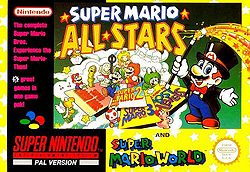
button to reveal the option of either continuing the game or quitting; neither option saves the game, unlike in the other games. The game's save feature is identical to the original game's, allowing the player to save only after they complete a castle, fortress, Ghost House, etc. Because of the nature of the file select, the player select screen is now shown after starting the game. While the other games do not allow a change in the number of players after a game is started, Super Mario World allows the player to change between one and two players even when resuming a saved game, as with the stand-alone version.


